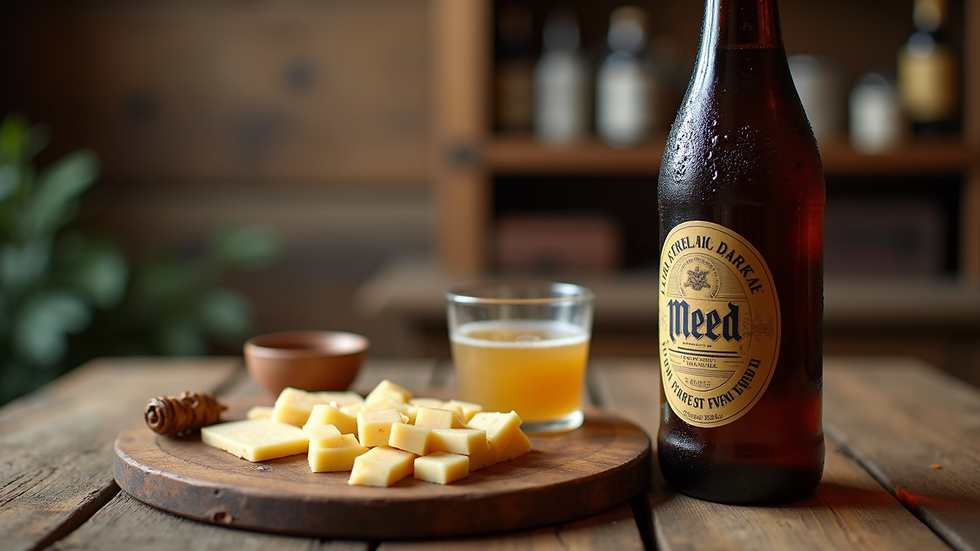Exploring New and Exciting Mead Flavors
- Elysium Meadery

- Sep 29
- 4 min read
Mead, often called the "nectar of the gods," is one of the oldest alcoholic beverages known to humanity. Traditionally made by fermenting honey with water, mead has evolved far beyond its simple origins. Today, mead makers experiment with a variety of ingredients, creating a diverse range of tastes and aromas. This exploration of new and exciting unique mead flavors offers a fresh perspective on this ancient drink, inviting enthusiasts and newcomers alike to discover something truly special.
Discovering Unique Mead Flavors
The world of mead is vast and varied. While classic meads focus on the pure honey flavor, modern mead makers are pushing boundaries by incorporating fruits, spices, herbs, and even unusual fermentables. These innovations result in complex and delightful profiles that appeal to a wide range of palates.
Some popular unique mead flavors include:
Berry-infused meads: Blueberries, raspberries, and blackberries add a tart and sweet balance.
Spiced meads: Cinnamon, cloves, and ginger bring warmth and depth.
Herbal meads: Lavender, chamomile, and rosemary introduce floral and earthy notes.
Citrus meads: Lemon, orange, and grapefruit zest brighten the flavor with refreshing acidity.
Botanical meads: Ingredients like hibiscus, elderflower, and juniper berries create intriguing layers.
For those interested in exploring a wide variety of these unique mead flavors, Elysium Meadery offers an excellent selection that showcases the creativity and craftsmanship behind modern mead making.

Berry-infused mead offers a vibrant and fruity taste experience.
How to Pair Mead with Food
Pairing mead with food can elevate both the drink and the meal. The versatility of mead means it can complement a wide range of dishes, from savory to sweet. Here are some pairing tips based on mead flavor profiles:
Sweet meads: Pair well with spicy dishes like Indian or Thai cuisine, as the sweetness balances heat.
Dry meads: Complement seafood, grilled chicken, or light salads.
Fruity meads: Match with desserts such as fruit tarts, cheesecake, or chocolate.
Spiced meads: Enhance roasted meats, stews, and hearty vegetable dishes.
Herbal meads: Pair nicely with Mediterranean dishes featuring herbs like rosemary and thyme.
Experimenting with food and mead pairings can be a fun way to discover new favorites. Start with small tastings and note which combinations excite your palate the most.

Mead pairs beautifully with a variety of cheeses and charcuterie.
Is Mead the Healthiest Alcohol?
Many people wonder if mead is a healthier choice compared to other alcoholic beverages. While alcohol consumption should always be moderate, mead does have some characteristics that might make it appealing from a health perspective:
Natural ingredients: Mead is primarily made from honey, water, and yeast, often with added fruits or herbs, avoiding many artificial additives.
Antioxidants: Honey contains antioxidants, which may carry over into the mead, especially in raw or minimally processed varieties.
Lower sulfites: Compared to wine, mead often contains fewer sulfites, which can cause sensitivities in some individuals.
Probiotic potential: Some traditional meads retain live yeast cultures, which might offer probiotic benefits.
However, mead still contains alcohol, which can have negative health effects if consumed excessively. It is important to enjoy mead responsibly and consider it as part of a balanced lifestyle.

Honey, the primary ingredient in mead, is known for its natural health benefits.
Crafting Your Own Unique Mead Flavors at Home
For those interested in creating their own mead, experimenting with flavors can be a rewarding hobby. Here are some practical tips for crafting unique mead flavors:
Start with a basic mead recipe: Use quality honey and clean water.
Choose your flavor additions: Fresh or dried fruits, spices, herbs, or even tea can be added during fermentation or aging.
Control fermentation temperature: This affects the final flavor and aroma.
Be patient: Mead often improves with age, sometimes requiring several months to a year.
Keep detailed notes: Record ingredients, quantities, and processes to replicate or improve your recipes.
Some interesting flavor experiments to try include:
Adding hibiscus flowers for a tart, floral note.
Infusing with vanilla beans and cinnamon sticks for a warm, dessert-like mead.
Using tropical fruits like mango or passionfruit for an exotic twist.
Homebrewing mead allows for endless creativity and personalization.
Exploring Mead Festivals and Tastings
One of the best ways to experience the diversity of mead is by attending mead festivals and tastings. These events bring together mead makers and enthusiasts, offering opportunities to sample a wide range of styles and flavors.
At festivals, you can:
Discover new mead brands and unique mead flavors.
Learn about the mead-making process from experts.
Participate in workshops and seminars.
Meet fellow mead lovers and share recommendations.
Many regions now host annual mead festivals, and some meaderies offer regular tasting events. Checking local event listings or meadery websites can help you find opportunities near you.

Mead tastings provide a chance to sample a variety of flavors in one sitting.
Embracing the Future of Mead
The resurgence of mead is driven by innovation and passion. As more people discover the charm of this ancient drink, mead makers continue to push the boundaries of flavor and style. Whether you prefer a traditional honey mead or an adventurous blend bursting with fruits and spices, there is a mead for everyone.
Exploring new and exciting unique mead flavors opens a world of taste and tradition. With so many options available, the journey into mead is as sweet and rewarding as the drink itself. Cheers to discovering your next favorite mead!




Comments